Lincoln Wheat Pennies, named for the iconic wheat ears on the reverse, were produced by various U.S. Mints and remain a popular collectible. The value of a 1954 Wheat Penny depends heavily on its condition and mint mark. Some coins may appear quite common, while higher-grade examples or rarities can be more valuable.
To determine the true worth of your 1954 cent, it’s highly recommended to consult a trusted coin grading service or a professional numismatist. Reputable price guides are also useful for cross-checking current market values.
1954 Wheat Penny Value Table by Condition
| Grade/Condition | 1954 (No Mint Mark) | 1954-D (Denver Mint) | 1954-S (San Francisco Mint) |
|---|---|---|---|
| Good | $0.06 | – | – |
| Very Good | $0.12 | – | – |
| Fine | $0.18 | $0.06 | $0.06 |
| Very Fine | $0.30 | $0.12 | $0.12 |
| Extra Fine | $0.42 | $0.14 | $0.14 |
| About Uncirculated | $0.54 | $0.24 | $0.24 |
| MS 60 (Mint State) | $0.72 | $0.60 | $0.60 |
| MS 63 | $2.44 | $1.22 | $1.22 |
| PR 63 (Proof Only) | $24 | / | / |
Note: Proof coins (PR) were only minted in Philadelphia and carry no mint mark.
History of the 1954 Wheat Penny
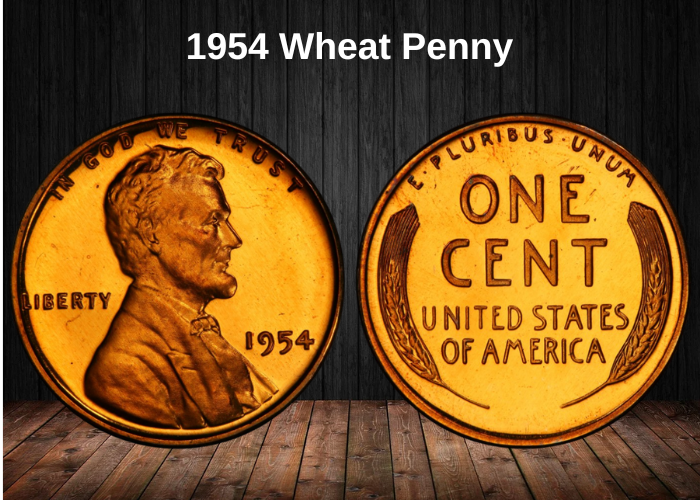
The 1954 Lincoln Wheat Pennies are part of the original fifty-year run of the Lincoln cent series, which debuted in 1909. These coins retained the same composition and overall design as the first issue, paying tribute to President Abraham Lincoln. Notably, they were the first U.S. coins in general circulation to feature a president’s portrait on the obverse—thanks to the vision of President Theodore Roosevelt.
As the 100th anniversary of Lincoln’s birth approached, it seemed only fitting to honor him with a coin. Roosevelt seized the opportunity, initiating a redesign that would eventually lead to the iconic Lincoln cent we know today.
1954 Wheat Penny Mintage by Location
| Mint Location | Type | Mintage |
|---|---|---|
| Philadelphia | 1954 (No Mint Mark) | 71,640,050 |
| Denver | 1954-D | 251,552,500 |
| San Francisco | 1954-S | 96,190,000 |
| San Francisco | 1954 Proofs | 233,300 |
| Total | – | 419,615,850 |
The man behind the design, Victor David Brenner, was an acclaimed engraver and sculptor. He had created a bronze plaque of Lincoln in 1907, and that very portrait served as the model for the coin’s obverse.
In 1954, the Philadelphia and Denver Mints were responsible for producing circulation (business strike) pennies, while San Francisco minted both proof coins and additional regular issues. Today, these cents remain a favorite among collectors, not only for their historical roots but also for their place in one of the most iconic series in U.S. coinage.
Key Features of the 1954 Wheat Penny
The 1954 Wheat Penny features the classic design created by Victor David Brenner, approved by President Theodore Roosevelt in 1909. This design was introduced to commemorate the centennial of Abraham Lincoln’s birth and quickly became an iconic piece among American coin collectors.
Not only did it honor one of the most beloved U.S. Presidents, but it also marked a historic moment: it was the first U.S. coin to feature a president’s portrait on the obverse, setting a long-standing tradition in American coinage.
The obverse of the 1954 Wheat Penny
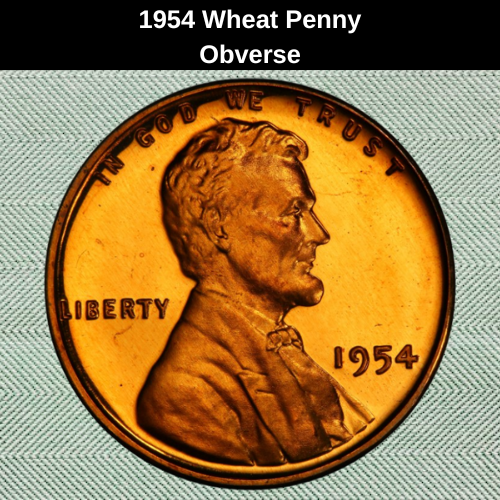
The obverse side of the 1954 Wheat Penny features a left-facing portrait of President Abraham Lincoln as the central design element. Thanks to the quality craftsmanship, you can clearly see the details of his beard, hair, and clothing, including the jacket collar and bow tie.
The word LIBERTY, which first appeared on U.S. coins in 1793, is engraved behind Lincoln’s shoulder. The minting year, 1954, appears on the right side of the field, just in front of Lincoln’s chest.
If present, the mint mark (S for San Francisco or D for Denver) is located just below the year. The phrase IN GOD WE TRUST, which became the official U.S. motto on all coins in 1955, is inscribed along the upper edge of the penny.
The reverse of the 1954 Wheat Penny
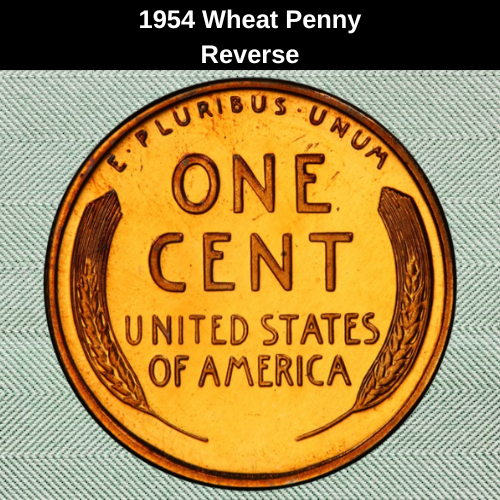
This reverse side, commonly referred to as the wheat design, was used on Lincoln cents starting in 1909. Initially, Victor David Brenner proposed a completely different reverse, but he redesigned it at the request of President Roosevelt.
The design includes two ears of wheat, one on each side along the left and right rims of the coin. These stalks symbolize national prosperity.
At the center, you’ll find the bold inscriptions ONE CENT and UNITED STATES OF AMERICA. Along the upper rim, you’ll see the Latin motto E PLURIBUS UNUM, meaning “Out of Many, One.”
1954 Wheat Penny Specifications
- Face value: One cent ($0.01)
- Shape: Round
- Diameter: 1.75 inches (19.05 mm)
- Weight: 0.1097 oz (3.11 g)
- Composition: 95% copper, with the remaining 5% zinc or tin
- Edge: Plain (no reeding)
- Thickness: 0.03937 inches (1 mm)
Other Features of the 1954 Wheat Penny
The 1954 Lincoln Wheat Penny is a round coin with a face value of $0.01. It was struck by the U.S. Mint using a cupro-zinc alloy composed of 95% copper and 5% zinc or tin.
Each coin has a diameter of 1.75 inches (19.05 mm), a thickness of 0.03937 inches (1 mm), and a weight of 0.1097 oz (3.11 g). These specifications remained standard throughout the Wheat Penny series before changes occurred in later years.
1954 Wheat Penny Grading
Grading a 1954 Wheat Penny involves assessing its condition and overall quality, which directly impacts its value. Coins are typically graded on the Sheldon Scale, ranging from Poor (P-1) — barely identifiable — to a perfect Mint State (MS-70).
Key factors in coin grading include:
- Signs of wear
- Surface luster
- Strike quality
- Eye appeal
Below is a simplified grading chart:
| # | Grade |
|---|---|
| 1 | Basal State-1 (Poor) |
| 2 | Fair (FR) |
| 3 | Very Fair (AG) |
| 4–6 | Good (G) |
| 7–10 | Very Good (VG) |
| 12–15 | Fine (F) |
| 20–30 | Very Fine (VF) |
| 40 | Extremely Fine (EF/XF) |
| 50 | About Uncirculated (AU) |
| 60 | Mint State (MS-60) |
| 65 | Mint State (MS-65) |
| 70 | Mint State (MS-70) |
For accurate appraisal, always refer to our coin grading guides or consult a professional numismatist. Proper grading is essential to determine your penny’s true market value.
1954 Wheat Penny Value Guides
1954 No mint mark Wheat Penny Value
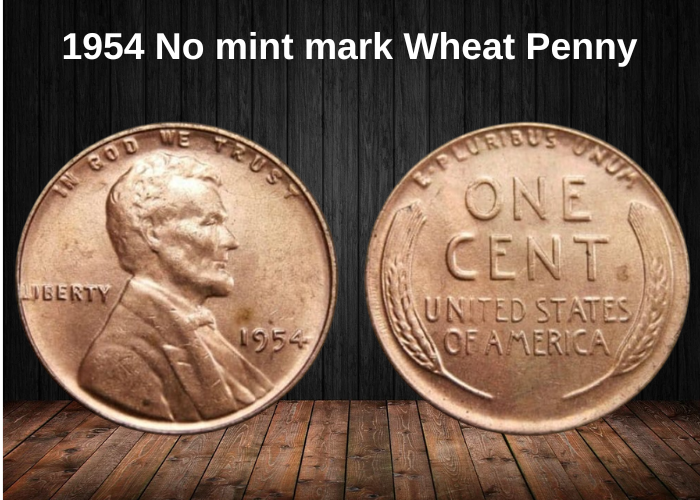
The 1954 pennies minted in Philadelphia had a total mintage of 71,640,050 coins. Their value depends greatly on their color classification (Brown, Red-Brown, or Red) and overall condition.
- Brown (BN) coins are the most affordable, typically valued between $0.71 and $12.50 for grades MS 60 to MS 66. Only MS 67 coins reach higher values, ranging from $35 to $45.
- Red-Brown (RB) specimens are priced from $3.50 to $55, generally within the MS 63 to MS 67 range.
- Red (RD) pennies tend to be the most desirable. While lower-grade red coins (MS 63) may sell for just $3.50, those graded MS 66 can command between $32 and $120.
- The rarest MS 67 RD examples can fetch anywhere from $7,800 to $10,000 on the open market. In fact, one exceptional coin sold for a staggering $31,200 at Heritage Auctions in January 2019.
1954 D Wheat Penny Value
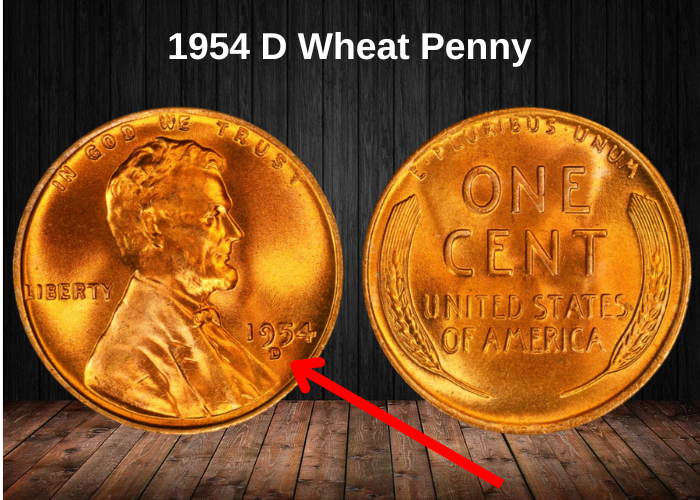
The 1954-D Wheat Cents were minted in Denver, and their value depends largely on condition, preservation, and rarity.
- Brown (BN) coins in grades MS 60 to MS 62 typically range from $0.50 to $1.
- Better-preserved examples graded MS 63 to MS 66 can reach up to $12.50, while top-tier MS 67 BN coins are valued at $24 to $45.
- Red-Brown (RB) coins have slightly higher values, selling for between $3.50 and $47.50 in MS 63 to MS 67 grades.
- As usual, Red (RD) coins command the highest prices:
- MS 63 RD – $6
- MS 64 RD – $12
- MS 65 RD – $20
- MS 66 RD – $36
- MS 67 RD – $475
1954 S Wheat Penny Value
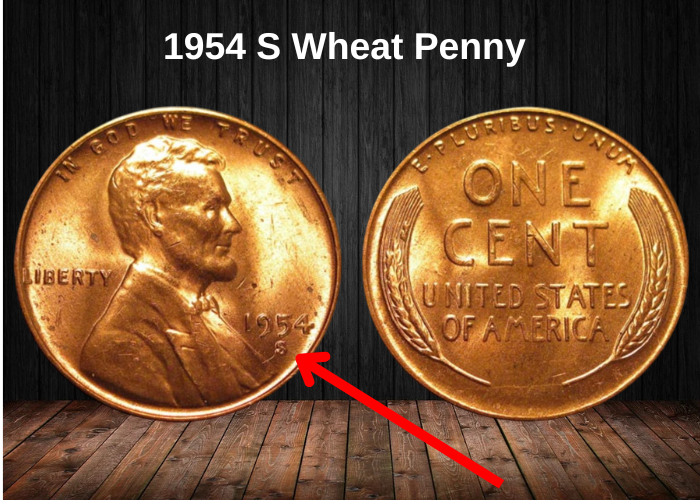
The San Francisco Mint produced both proof and regular strike coins in 1954. Regularly minted cents are generally affordable, with prices depending on grade and color:
- Brown (BN) coins in MS 60 and MS 64 grades typically range from $0.50 to $2.50.
- Better-graded coins, MS 65 and MS 66, cost approximately $5 to $12.50.
- The most valuable brown (BN) pennies, those graded MS 67, are worth $37 to $47.
Red-Brown (RB) coins are pricier, ranging from $3.50 for MS 63 pieces to $17.50 for MS 66 coins. The highest-priced red-brown coins are those graded MS 67, with an estimated value of $35 to $57.
1954 S Wheat Penny proofs
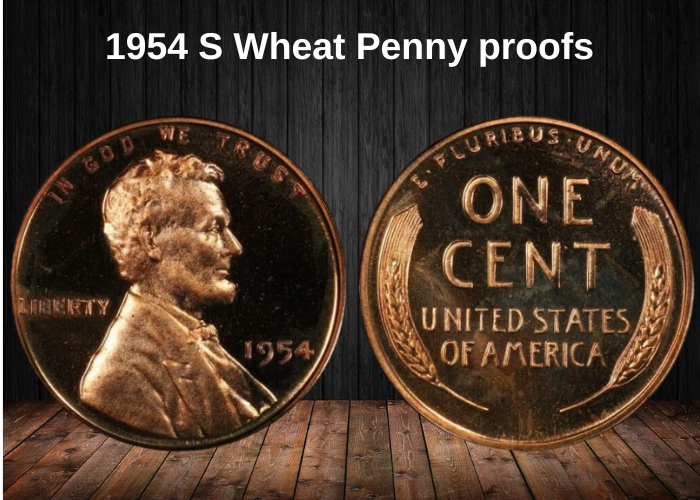
The San Francisco Mint produced proofs in 1954 in addition to regular coinage. Their value depends on grade, color, and variety. Here’s the breakdown:
- Brown (BN) proof pennies start at $1.50 for those graded PR 60.
- Better-rated coins:
- PR 61: $2
- PR 66: $12
- PR 67: $25 to $30.
Red-Brown (RB) pennies range from $2 to $36, depending on their quality.
Red (RD) pennies are the most desirable, with prices starting at $12 for PR 60.
- Higher quality red coins are estimated at:
- $5 to $45 for PR 61 to PR 67.
- Above PR 68: $325 or more.
Special CAM (Cameo) and DCAM (Deep Cameo) red varieties can fetch significantly higher prices. For instance:
- CAM-graded coins in MS 65 and MS 66 are worth $60 to $100.
- DCAM-graded coins can range from $350 to $800.
For the most pristine coins, prices are as follows:
- Red PR 67 CAM penny: $265
- Red PR 67 DCAM penny: $1,150
- Red PR 68 CAM penny: $2,100
- Red PR 68 DCAM penny: $15,000
Rare 1954 Wheat Penny Errors List
Errors are common in the minting process and can occur for various reasons. Only rare imperfections can significantly increase coin value. Here are some of the most prominent errors that occurred during the 1954 Wheat cent minting:
Doubled die
The doubled die error happens when there is a misalignment during the minting process, resulting in a doubled appearance of certain features on the coin. Depending on which side the error occurs, you can have a DDO (Doubled Die Obverse) or DDR (Doubled Die Reverse). The 1954 Wheat Pennies feature both types of errors, caused by a misalignment between the die and the working hub.
DDO (Doubled Die Obverse)
- Location: The error is on the obverse side of the coin.
- Visible Features: Doubling is often noticeable in the date and the word LIBERTY.
- Key Detail: The doubling effect typically appears on the letters in the date or the inscription LIBERTY, making the text look blurry or shadowed.
- What to Look For: If you notice multiple impressions of the same letter, particularly in the year or “LIBERTY,” it’s a good indicator of a DDO.
DDR (Doubled Die Reverse)
- Location: This error affects the reverse side of the coin.
- Visible Features: The doubling is most often seen in the wheat stalks and the mint mark.
- Key Detail: The mint mark (either D or S) is typically the most noticeable area where the doubling occurs. You might see a second, slightly misaligned mint mark just below or beside the original one.
- What to Look For: Examine the mint mark closely; it may appear doubled or split, especially when magnified.
Mint Mark Doubling
- Main Feature: The mint mark doubling is a distinctive characteristic of the 1954 penny, particularly in the D and S mint marks.
- Recognition: The mint mark may show an overlap or a faint second impression due to the die’s misalignment.
How to Identify the Doubled Die Errors
- Examine the Letters and Numbers: On DDO, look for splitting or shadows around the year and LIBERTY.
- Check the Mint Mark: On DDR, look closely at the mint mark for any signs of duplication or misalignment.
- Observe Both Sides: The error can appear on either side of the coin, and the more pronounced the doubling, the more valuable the coin can be.
Both DDO and DDR errors in 1954 Wheat Pennies are highly collectible, especially when the doubling is clear and sharp. These coins can be worth a lot more than regular ones, making them a prized possession for coin collectors.
Re-punched mint mark
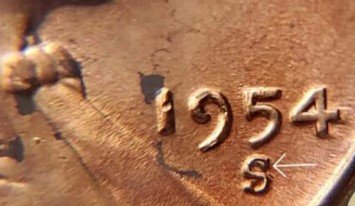
The RPM error occurs when the mint mark on a coin is punched twice in the minting process, typically to correct a previous mistake. This results in overlapping mint marks, although some coins feature a separate second mint mark. These errors are quite valuable, especially when the second mark is clear and distinct.
Key Features of RPM Errors
- Cause: The mint mark is applied more than once, often because of a worker’s effort to fix a previous mistake.
- Result: The mint mark overlaps or appears doubled on the coin. In rarer cases, the second mint mark is distinct and located near the first one.
- Coin Types: The RPM error is particularly common on the 1954 S pennies and 1954 D/D pennies.
RPM 1954 S Pennies
- Value: Generally, these pennies with the RPM error are valued around $20.
- Key Feature: The error is often subtle but can be noticeable upon close inspection, especially around the mint mark.
RPM 1954 D/D Pennies
- Value: A D/D RPM penny typically costs around $90, though it can vary depending on condition.
- Auction Record: A coin with this error, graded MS 66, set an auction record in 2018, selling for $300.
How to Identify RPM Errors
- Examine the Mint Mark: The primary characteristic is doubling or overlapping of the mint mark. Look for a second mint mark that is either slightly shifted or faintly visible near the original one.
- Check the Placement: For a D/D RPM or S/S RPM, the mint mark should appear close to the first, with a noticeable overlap or additional mark.
Collectibility: RPM errors are highly sought after by collectors due to their rarity and the unique nature of the minting mistake. As with most coin errors, the more pronounced and clear the error, the higher the value.
Die break (BIE)
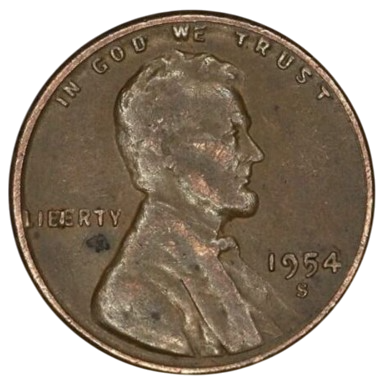
The BIE error is a type of die break or cud that occurs when a raised area forms between the B and E in LIBERTY on the coin. This is caused by a die clash, where two dies make contact, resulting in an imperfection.
Key Features of the BIE Error
- Cause: The BIE error occurs due to a die break or cud, where a raised area forms between the B and E in the word LIBERTY. This is a result of a die clash, which happens when the dies improperly contact each other during the minting process.
- Appearance: It looks like an extra “I” between the B and E, making it appear as BIE instead of BE.
- Rarity: While the BIE error can appear on many pennies, it is not an extremely rare occurrence, and most BIE pennies do not significantly increase in value.
Value of BIE Error on 1954 Pennies
- General Value: The BIE error does not typically add much value to the coin, as it is relatively common. However, well-preserved examples can be worth around $30, especially if they are in higher grades.
- Collectibility: While not a top-tier error, BIE errors are still of interest to collectors who focus on minor errors and die varieties.
Identifying the BIE Error
- Look Between the Letters: The most distinctive feature is the raised area between the B and E in LIBERTY, which creates the appearance of an extra I.
- Examine the Die Break: The die break typically appears as a raised metal lump, causing the letters to appear altered.
Broad strike
A broad strike error occurs when a coin is struck outside of its retaining ring, which helps define its final diameter. This causes the coin to spread out beyond its normal size, resulting in a wider than usual coin with the full design visible on both sides.
Key Features of the Broad Strike Error
- Cause: A broad strike happens when the cent is struck without the retaining ring that is used to define its diameter. Without this constraint, the coin expands as it is struck, leading to a coin that is wider than normal.
- Visible Design: For a coin to be considered a broad strike error, the complete design must be visible on both sides. If the coin is too deformed or the design is missing, it is not classified as a broad strike.
- Diameter: The coin will be larger than normal because it has not been confined by the retaining ring, leading to the design being spread out.
Value of the Broad Strike Error on 1954 Wheat Pennies
- General Value: Broad strike coins are typically less valuable than more significant errors. You can expect to pay up to $10 for a 1954 broad strike penny in typical grades.
- Rarity: Broad strikes are not extremely rare, but they are not common either, so they hold some collectible interest.
Identifying the Broad Strike Error
- Wider Coin: The most obvious feature of a broad strike is the coin’s larger-than-normal size.
- Complete Design: Ensure that the full design (both obverse and reverse) is visible and not distorted due to the broadening of the coin.
- Flat Edges: The edges of a broad strike coin may be flattened or slightly out of round due to the absence of the retaining ring.
Die-deterioration doubling
A worn-out die can cause visible doubling on various design features, resulting in either raised or sunken doubling. This imperfection typically appears on the letters, mint mark, and numbers of the 1954 penny. The design elements may show a distorted or doubled image due to the die’s deterioration, giving the coin a unique and sometimes faint appearance.
Where to sell your penny?
Now that you know the value of your penny, you might be wondering where to sell it. Don’t worry: here’s a guide to some of the best online platforms where you can easily sell your coins, along with their advantages and disadvantages.
Discover the best platforms for selling coins online (pros and cons).
FAQ about the 1954 Wheat Penny
1. Why is the 1954 Wheat Penny significant in U.S. coinage history?
The 1954 Wheat Penny is important because it represents the final full year of the Wheat reverse design used on U.S. pennies. After 1954, the U.S. Mint began preparing for the change to the Lincoln Memorial reverse design, which was first introduced in 1959. As a result, the 1954 penny is one of the last to feature the iconic Wheat stalks on the reverse side of the coin, making it significant for collectors interested in this historical design transition.
2. What is the metal composition of the 1954 Wheat Penny?
The 1954 Wheat Penny is made of:
- 95% copper
- 5% zinc
This composition was the standard for U.S. pennies from 1909 to 1942 and from 1944 to 1958, before the Mint switched to a copper-plated zinc alloy in the 1960s. The 1954 penny is therefore part of the copper-based series that is highly sought after by collectors today.
3. How many 1954 Wheat Pennies were minted?
The 1954 Wheat Penny had a substantial mintage:
- Philadelphia (no mintmark): 1,112,660,000
- Denver (D): 208,840,000
- San Francisco (S): 33,990,000
With a total mintage of over 1.35 billion pennies, the 1954 Wheat Penny is one of the most common in the Wheat series. However, as with any coin, higher-grade examples and those with errors or unique characteristics are more valuable to collectors.
4. What is the value of a 1954 Wheat Penny today?
The value of a 1954 Wheat Penny depends on its condition:
- Circulated coins: Typically worth around $0.05 to $0.25.
- Uncirculated coins: Coins graded MS-63 or MS-64 can be worth around $1 to $10.
- High-grade coins: Coins graded MS-65 or higher may be worth $15 to $30, and in pristine condition (MS-66 or higher), they can be worth $40 or more.
While the mintage is high, coins in mint condition, especially those with error varieties, can still command a premium.
5. Are there any notable error varieties in the 1954 Wheat Penny?
Yes, there are a few error varieties that can make the 1954 Wheat Penny more valuable:
- Double Die Obverse (DDO): Some 1954 pennies show a doubled die on the obverse, especially in the “LIBERTY” and “IN GOD WE TRUST” inscriptions. These doubled dies occur when the die is struck multiple times, resulting in a double image that is visible to the naked eye.
- Off-center Strikes: Like many other years, some 1954 pennies were struck off-center, causing part of the design to be misaligned or missing entirely.
- Die Cracks and Cuds: Some 1954 pennies feature die cracks or cud marks (raised areas caused by die damage). These errors can make the coin more interesting and collectible.
Coins with these errors tend to be worth more than regular examples in lower grades.
6. How does the 1954 Wheat Penny compare to other years in the Wheat series?
The 1954 Wheat Penny is quite similar to other pennies from the early 1950s, but it is especially notable because it is part of the final years of the Wheat reverse design. After 1954, the Mint switched to the Lincoln Memorial reverse, which started in 1959.
Compared to earlier coins in the series, the 1954 penny is a little more common due to the large mintage, but it remains significant to collectors due to its place at the end of the Wheat series. Collectors who are specifically focused on Wheat pennies often seek out high-grade examples from 1951 to 1954 because they represent the last of the design before the change to the Memorial reverse.
7. How can I identify a high-grade 1954 Wheat Penny?
To identify a high-grade 1954 Wheat Penny, look for the following characteristics:
- Sharp details: The wheat stalks, Lincoln’s portrait, and inscriptions should be well-defined and sharp. No details should be worn or faded.
- Minimal wear: A high-grade coin will show no wear on the high points, like Lincoln’s cheek, the wheat heads, and the rim. The coin should look as though it has never been in circulation.
- Clean surfaces: The coin should have smooth, clean surfaces with no scratches, abrasions, or toning. It should be free from distracting marks.
- Luster: High-grade uncirculated coins will retain their original luster—a reflective surface that gives the coin a shiny, fresh appearance. Coins with MS-65 or higher grades will show minimal imperfections and will shine brightly in the light.



















































